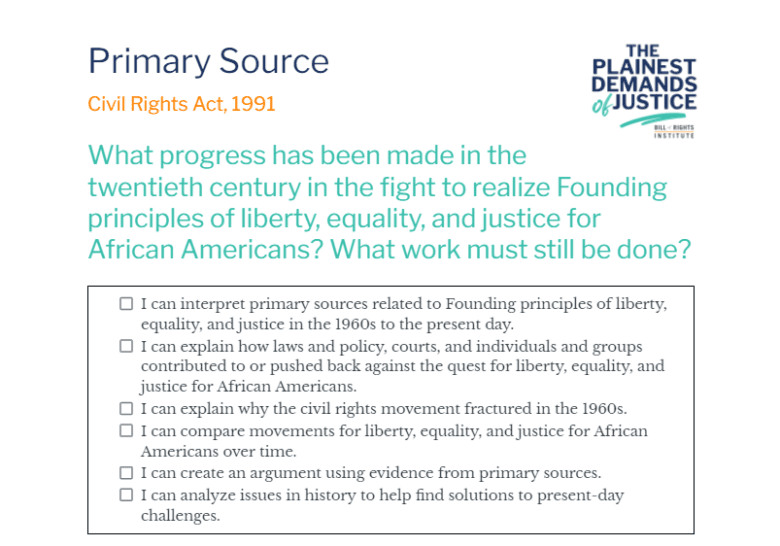Civil Rights Act, 1991
What progress has been made in the twentieth century in the fight to realize Founding principles of liberty, equality, and justice for African Americans? What work must still be done?
- I can interpret primary sources related to Founding principles of liberty, equality, and justice in the 1960s to the present day.
- I can explain how laws and policy, courts, and individuals and groups contributed to or pushed back against the quest for liberty, equality, and justice for African Americans.
- I can explain why the civil rights movement fractured in the 1960s.
- I can compare movements for liberty, equality, and justice for African Americans over time.
- I can create an argument using evidence from primary sources.
- I can analyze issues in history to help find solutions to present-day challenges.
Building Context
The Civil Rights Act of 1991 was signed by President George H. W. Bush on November 21, 1991. This act provided the right to trial by jury in cases with discrimination claims and introduced the possibility of emotional distress damages resulting from intentional employment discrimination.
Civil Rights Act, 1991
Source: https://www.eeoc.gov/civil-rights-act-1991-original-text
An Act To amend the Civil Rights Act of 1964 to strengthen and improve Federal civil rights laws, to provide for damages in cases of intentional employment discrimination, to clarify provisions regarding disparate impact actions, and for other purposes.
The Congress finds that—
(1) additional remedies under Federal law are needed to deter unlawful harassment and intentional discrimination in the workplace;
. . .
(3) legislation is necessary to provide additional protections against unlawful discrimination in employment.
. . .
The purposes of this Act are—
(1) to provide appropriate remedies for intentional discrimination and unlawful harassment in the workplace;
. . .
(4) to respond to recent decisions of the Supreme Court by expanding the scope of relevant civil rights statutes in order to provide adequate protection to victims of discrimination.
Comprehension and Analysis Questions
- What was the purpose of this act?
- Both this document and The Civil Rights Act of 1968 (or the Fair Housing Act) expanded the 1964 Civil Rights Act. What does this reveal about the nature and purpose of legislation?
